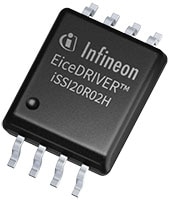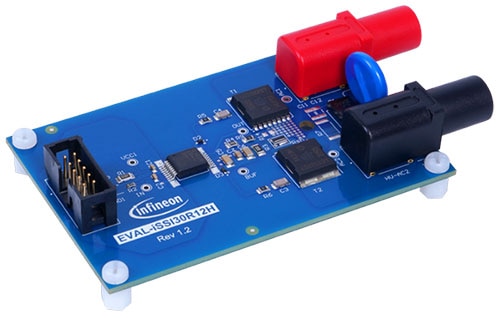固态隔离器比光学继电器更具优势
在为电子应用选择元器件时,很容易依赖熟悉可靠的产品。对现有选择的熟悉程度、老技术的低成本或对新集成挑战的犹豫不决,都可能成为做出新选择的阻碍因素。但是,在考虑采用较新的固态隔离器 (SSI) 技术而非其他替代技术时,产品设计人员可能还需要考虑“现在不买单,以买大单”的问题。
2024 年初,Infineon Technologies 推出全新固态隔离器 (SSI) 产品系列(图 1),该产品系列采用无芯变压器技术,支持高出 20 倍的能量传递能力、更可靠的电路开关能力以及光学固态继电器 (SSR) 所不具备的保护功能。与电磁继电器 (EMR) 相比,它们还能将导通功率降低 40% 并且附带其他好处。
 图 1:Infineon iSS120R02H 是该公司众多固态隔离器中的一种,基于无芯变压器技术,可用于固态继电器。(图片来源:Infineon Technology)
图 1:Infineon iSS120R02H 是该公司众多固态隔离器中的一种,基于无芯变压器技术,可用于固态继电器。(图片来源:Infineon Technology)
利用这些 SSI,开发人员可以打造出坚固耐用的定制 SSR,能够控制超过 1000 V 和 100 A 负载。这些隔离器可实现跨隔离栅能量传递,以驱动大功率 MOSFET 和绝缘栅双极晶体管 (IGBT),而无需隔离偏置电源来驱动栅极。
SSI 的长期优势和可靠性可以抵消使用光耦合器或 EMR 所能节省的费用。虽然将这些器件集成到应用中一开始可能会需要适应一段时间,但任何技术进步通常都是如此。
更直接的电源设计和更长期的可靠性是客户满意度的重要因素,因此工程师应在材料费用与长期成本之间取得平衡。Infineon SSI 出色的性能以及电流和温度保护功能可带来更高的可靠性,并降低总拥有成本。
Infineon 的 SSI 没有 EMR 特有的活动零件,与光学 SSR 相比,具有更快的开关速度和更低的功率耗散,可为电子应用带来更高的性能、可靠性和更好的热效率,最大限度地减少对散热器的需求。在光学固态继电器中,LED 会随着时间的推移而老化,而 SSI 依靠的是无芯变压器技术,在设计上就能够实现更高的长期可靠性。
Infineon SSI 的输入端兼容 3.3 V 电压,并集成了一个电源缓冲电容器。其电源基于模拟二极管结构的并联稳压器。虽然可以外接缓冲电容器,但没有必要。它们能够提供最高 18 V 的高输出电压,栅极驱动无需串联或并联配置。
据 Infineon 称,它们的输出电压 (VOUT) 足以驱动 MOS 控制的晶体管,包括 Infineon 的 CoolMOSTM 和 OptiMOSTM 系列功率 MOSFET 以及其 TRENCHSTOPTM 系列 IGBT。应用可利用先进的输出端控制功能,包括快速导通和快速关断、过热保护和过流保护。该系列中的所有器件均通过了 IEC 60747-17 和 UL1577 认证。
Infineon 器件可用于定制 SSR,广泛应用于从工业设备到电网和可再生能源的高压和大电流领域。这些器件可集成到配电、电源、自动测试设备、机器人、仪器仪表系统、高级电池管理以及众多其他应用中。
以 Infineon 的 SSI 产品系列中的 iSSI30R12H 为例,它采用 DSO-16-33 封装,带有集成温度传感器,专为与 CoolMOS™ S7 T-Sense 功率 MOSFET 配合使用而定制。该隔离器的输入端兼容 3.3 V,工作时的供应电流通常为 16 mA。
该系列中与外部 PTC 电阻器配合使用的其他器件包括:
- iSSI20R02H、iSSI20R03H 和 iSSI20R11H,均采用 DSO-8-66 封装。
- iSSI30R11H,采用 DSO-16-33 封装
Infineon 还针对其 SSI 产品系列提供评估板。例如,Eval-iSSI30R12H(图 2)包括一个 iSS130R12H 和两个采用交流开关配置的 CoolMOS™ IPT60T022S7 MOSFET,其控制接口可连接到脉冲发生器、单片机或其他具有适当驱动能力(至少 25 mA)的数字电路。
 图 2:EVAL-iSSI30R12H 是测试 Infineon 固态隔离器产品线所用的几种评估套件之一。(图片来源:Infineon Technology)
图 2:EVAL-iSSI30R12H 是测试 Infineon 固态隔离器产品线所用的几种评估套件之一。(图片来源:Infineon Technology)
结语
Infineon 的固态隔离器系列在为客户定制固态继电器方面具有重要的性能、可靠性和热管理优势。与电磁继电器和光学 SSR 相比,固态隔离器因为没有活动零件,能量传递更强,而给应用带来了更高的性能、更长的寿命选择,即便一开始需要学习和适应一下也是值得的。

Have questions or comments? Continue the conversation on TechForum, Digi-Key's online community and technical resource.
Visit TechForum










